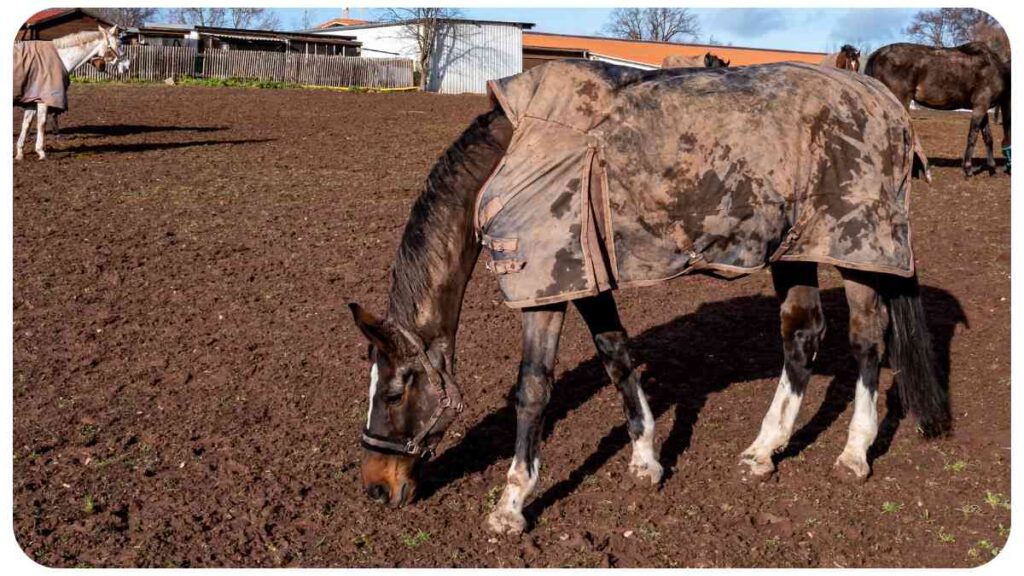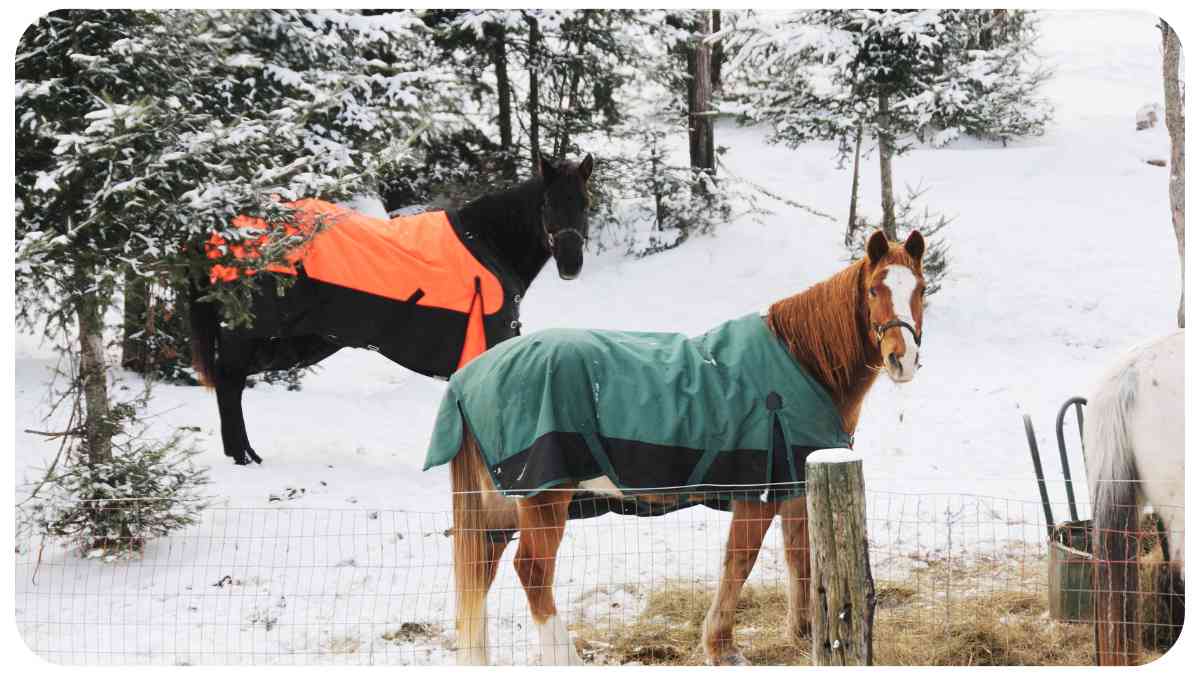Welcome to our guide on fixing your horse’s blanket! As an experienced professional in the equestrian world, I understand the frustration that can arise when your horse’s blanket encounters issues. Whether it’s an ill-fit or a tear, these problems can be easily remedied with the right knowledge and techniques.
In this article, I will share troubleshooting tips, maintenance advice, and preventive measures to ensure your horse stays warm, comfortable, and protected. So, let’s dive in and discover effective solutions for common blanket problems.
| Takeaways |
| 1. Properly fitting blankets are essential for your horse’s comfort and freedom of movement. Measure your horse accurately and refer to sizing charts to ensure the right fit. |
| 2. Regular inspections and cleaning help identify and address minor issues before they worsen. Pay attention to closures, leg straps, and waterproofing properties. |
| 3. Repairing small tears can be done using needle and thread, while larger tears may require a sewing machine or patch repair kit. Promptly address any damage to maintain the blanket’s warmth retention. |
| 4. Maintain and store blankets properly during the offseason. Thoroughly clean and dry the blanket before storing it in a cool, dry location. Consider using a breathable storage bag or container. |
| 5. Seek professional help for extensive repairs, significant damage, or specific modifications. Consulting with experts ensures the best outcome for your horse’s blanket. |
Understanding Common Blanket Issues
Before we delve into troubleshooting tips, it’s crucial to understand the common issues your horse’s blanket may face. This knowledge will allow you to identify the problem accurately and apply the appropriate fix.
Having a well-fitted horseback riding boots is crucial for both comfort and safety properly fitting horseback riding boots. It ensures a secure grip and reduces the risk of accidents during rides. Invest in high-quality boots that provide proper ankle support and are designed for equestrian activities.
Ill-fitting Blankets
One of the most frequent problems horse owners encounter is an ill-fitting blanket. An improperly fitting blanket can cause discomfort, chafing, and restrict your horse’s freedom of movement. To address this issue effectively, it’s essential to determine the correct size for your horse. Refer to the manufacturer’s sizing chart and measure your horse accurately, taking into account their height, weight, and body shape.
Table: Common Horse Blanket Sizes
| Horse Size | Measurement Range (inches) |
| Pony | 58 – 64 |
| Cob | 66 – 70 |
| Horse | 72 – 76 |
| Oversize | 78 – 84 |
Torn or Ripped Blankets

Another problem you may encounter is a torn or ripped blanket. Horses can be playful and, on occasion, exhibit their knack for damaging their blankets. When facing a tear, it’s crucial to address it promptly to prevent further damage and ensure your horse’s warmth retention. Repairing a torn blanket requires some DIY skills and the right tools.
Table: Essential Tools for Repairing Blankets
| Tool | Purpose |
| Needle and Thread | Stitching smaller tears and snags |
| Sewing Machine | Ideal for larger tears and more extensive repairs |
| Patch Repair Kit | Provides durable patches for larger areas |
| Blanket Clips | Help secure blankets, preventing further fraying |
Troubleshooting Tips
Now that we’ve identified the common issues, let’s explore troubleshooting tips to address them effectively.
Adjusting an Ill-fitting Blanket
To fix an ill-fitting blanket, follow these steps:
- Ensure the blanket sits properly on your horse’s withers, shoulders, and hindquarters, without causing any pressure points.
- Adjust the front closure to ensure a snug but comfortable fit. The blanket should neither be too loose nor too tight.
- Check if the leg straps are correctly adjusted and not too loose to prevent accidents.
- Assess the blanket’s length and ensure it covers your horse’s body adequately, without dragging on the ground.
For riders of every discipline, finding the right bridle is essential for effective communication horseback riding bridles for every discipline. The right bridle will ensure proper control and aid in steering your horse. Whether it’s a snaffle, double bridle, or bitless bridle, choose one that suits your horse’s needs and your riding style.
Repairing Torn or Ripped Blankets
When dealing with a torn or ripped blanket, use the following steps:
- Clean the damaged area and remove any debris or loose threads.
- For smaller tears, use a needle and thread to stitch the fabric together, ensuring the stitches are secure and evenly spaced.
- For larger tears, employ a sewing machine for stronger and more reliable stitching.
- Consider using a patch repair kit to reinforce the damaged area, ensuring the blanket’s longevity.
Maintenance and Prevention
Maintaining your horse’s blanket is key to prolonging its lifespan and ensuring its effectiveness. Regular inspections and cleaning play a vital role in keeping the blanket in top condition, while proper storage prevents damage during the offseason.
Maintaining proper hoof care is essential for your horse’s soundness and performance hoof care 101: keeping your horse’s feet in top shape. Regular trimming, cleaning, and proper shoeing, if necessary, contribute to healthy hooves. Invest in a good farrier and educate yourself on basic hoof care practices to prevent common issues like cracks, thrush, or imbalances.
Regular Inspections and Cleaning
Regularly inspecting your horse’s blanket allows you to identify any minor issues before they escalate. Follow these guidelines for inspections:
- Check the blanket for loose threads, worn-out areas, or potential weak points.
- Examine the closures, leg straps, and surcingles to ensure they are intact and functioning properly.
- Inspect the waterproofing properties, paying attention to any areas that may need reproofing.
Cleaning your horse’s blanket regularly helps maintain its hygiene and extend its lifespan. Here’s a simple cleaning routine to follow:
- Remove excess dirt and debris from the blanket using a brush or gentle hose-down.
- Use a non-detergent soap or specialized blanket cleaner to spot clean any stains or heavily soiled areas.
- Ensure thorough rinsing to eliminate all soap residues.
- Hang the blanket to air dry completely before storing it.
Equip yourself with the necessary riding gear to enhance your horseback riding experience essential horseback riding equipment pieces. From helmets and body protectors to sturdy boots and gloves, the right equipment provides safety and comfort. Prioritize high-quality gear that fits well and meets safety standards for a worry-free ride.
Storing Blankets Properly
Proper storage is crucial, especially during the offseason when your horse doesn’t require a blanket. Keep the following tips in mind when storing your horse’s blanket:
- Clean the blanket thoroughly before storing it to prevent dirt or mold from setting in.
- Ensure the blanket is completely dry before folding or rolling it for storage.
- Choose a cool, dry location to prevent mildew or moisture damage.
- Consider using a breathable storage bag or container to discourage pests or dust accumulation.
When to Seek Professional Help
While many blanket issues can be resolved with DIY techniques, there may be situations where seeking professional assistance is the best course of action. Instances where professional help may be required include:
- Extensive blanket repairs that are beyond your skill level or equipment capabilities.
- Significant tears or damage that compromises the blanket’s waterproofing or insulation.
- Modifications or alterations to tailor the blanket for a better fit or accommodate specific needs.
When in doubt, consult with an equestrian professional or a reputable blanket repair service. They can provide expert advice and ensure the best outcome for your horse’s blanket.
Conclusion
In conclusion, ensuring your horse’s blanket is in optimal condition is vital for their comfort and well-being. By understanding common blanket issues, employing troubleshooting tips, practicing maintenance routines, and knowing when to seek professional help, you can enhance the longevity and effectiveness of your horse’s blanket.
Remember, regular inspections, proper cleaning, and suitable storage techniques go a long way in keeping your horse snug and cozy. Enjoy your time with your equine friend, knowing they are well-protected in their perfectly fitting and intact blanket.
A well-balanced and nutritious diet is crucial for your horse’s overall health and well-being proper forage in a horse’s diet. Including ample amounts of high-quality forage such as hay or pasture is essential for their digestive system and overall nutrition. Consult with a veterinarian or equine nutritionist to determine the right forage options for your horse’s specific needs.
Further Reading
For more information on fixing your horse’s blanket and related topics, check out the following resources:
- How to Inspect and Repair Common Horse Blanket Issues: This article provides insights into common issues with horse blankets and offers guidance on how to identify and resolve them effectively.
- Mid-Winter Blanket Repair Tips: Learn essential tips for repairing your horse’s blanket during the winter months. Discover techniques to keep your horse warm and protected when facing unexpected blanket mishaps.
- The Ultimate Horse Blanket Guide: This comprehensive guide covers everything you need to know about horse blankets, including selecting the right size, understanding different types of blankets, and proper care and maintenance.
FAQs
Can I patch a small tear in my horse’s blanket myself?
Yes, for smaller tears, you can patch them yourself using a needle and thread or even a sewing machine. It’s important to ensure the stitching is secure and evenly spaced for durability.
How often should I inspect my horse’s blanket?
It’s recommended to inspect your horse’s blanket regularly, approximately once a week during the winter months. This allows you to catch any issues early on and address them promptly.
What should I do if my horse’s blanket becomes wet?
If your horse’s blanket becomes wet, it’s crucial to remove it and allow it to dry completely before putting it back on your horse. Wet blankets can lead to discomfort and potential health issues.
How should I store my horse’s blanket during the offseason?
When storing your horse’s blanket during the offseason, ensure it is thoroughly cleaned and completely dry. Choose a cool, dry location and consider using a breathable storage bag or container to prevent mildew and pest infestation.
Is it necessary to reproof my horse’s blanket?
Over time, the waterproofing properties of your horse’s blanket may diminish. If you notice that water is no longer beading off the fabric, it’s a good idea to reproof the blanket using a suitable waterproofing product. Follow the manufacturer’s instructions for best results.

Hi there! My name is Hellen James, and I’m a horse riding expert. I’ve been riding horses since I was just a kid—and it’s been my passion ever since. But getting started with horse riding can be overwhelming. There’s so much to learn! If you’re looking for a way to get started and make sure you’re doing it right, I’m here to help.


